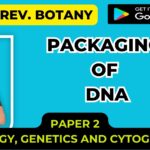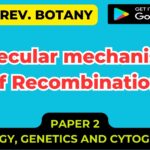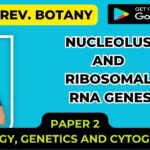![]()
Molecular Mechanism of Chromosomal Pairing
- Homologous chromosomes start pairing at one or more points along the lengths of chromosomes during this stage.
- Pairing extends along the rest of the chromosome length in a zipper like fashion.
- Although heredity, temperature, nutrition, etc. are known to affect pairing, the mechanism of pairing is not well understood.
- Pairing or synapsis is a very precise process in which only homologous parts of chromosomes come together.
- Non-homologous parts are looped out and thus remain unpaired.
- A pair of homologous chromosomes is called bivalent .
- At any one point only two chromosomes can get paired.
- This is evident when three or four homologous chromosomes are held together to form multivalent, but even then at any given point only two chromosomes are paired.
- Under the electron microscope the synaptonemal complex appears multilayered.
- There is a central axis which is flanked on both the sides by an axial element.
- There is a central space in between the central and axial elements.
- Chromatin is dispersed towards the outer faces of the axial element.
- DNase destroys the chromatin but not the axial or central elements.
- These are destroyed by trypsin, indicating thereby that both the central and axial elements are proteinaceous in nature.
- The central axis is composed of a substance which is synthesized during pairing.
- Synaptonemal complexes not formed if the homologous are experimentally prevented from pairing.
- The ends of chromosomes are attached to the inner surface of the nuclear membrane at this stage.
- A part of the DNA (about 0.3%in lilium) that remains unreplicated during interphase is replicated during this stage of meiosis














